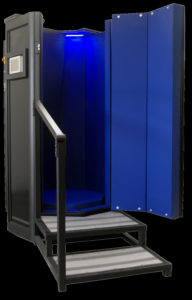Whole Body Cryotherapy is a popular treatment in sports medicine that involves standing in a very cold (typically -110° C/-166°F) cryotherapy chamber for 2-4 minutes. It has been suggested that some of cryotherapy’s purported benefits may be helpful for certain medical conditions as well. Unfortunately, there is a lot of misinformation out there about the benefits of cryotherapy, but there are reasons to consider this therapy in new applications such as lipedema. (Not sure what lipedema is? Read this.)


Whole Body Cryosauna (Photo: Wikimedia Commons, Popeallstar32)
Cryotherapy should not be confused with cryolipolysis, which is a fat-reduction procedure that includes CoolSculpting. In my opinion, cryolipolysis is not appropriate for lipedema because you are intentionally damaging adipocytes (fat cells) which is part of the pathophysiology of lipedema, and you are relying on a functional lymphatic system to carry the cellular and inflammatory debris away. Many people with lipedema have some degree of lymphatic impairment.
Conversely, there is no evidence that cryotherapy causes damage to adipocytes or disrupts cellular integrity. (1)
At this point we do not have any studies specifically studying cryotherapy in lipedema and we cannot necessarily extrapolate the benefits shown in certain populations to those with lipedema. Most studies on cryotherapy are in athletes and the therapy is timed in conjunction with exercise. However, there are several ways that cryotherapy could potentially benefit patients with lipedema.
Increasing Thermogenesis
Cryotherapy has been proposed as a treatment for obesity and type II diabetes due to its ability to somewhat mimic exercise, inducing increased expression of myokines (IL-6 and irisin) that affect adipose tissue (fat). (2) Lipedema is a disease of white adipose tissue. White fat is less metabolically active and too much of it can increase risk for conditions like diabetes and heart disease. Brown fat uses more energy, generating heat in a process called thermogenesis, and can help maintain leaner body mass. Irisin helps convert white fat to brown fat, increasing thermogenesis. In theory, cryotherapy could benefit patients with lipedema by helping convert the affected white adipose tissue into more thermogenic brown adipose tissue.
Reducing Comorbidities
Patients with lipedema can have metabolic comorbidities including atherosclerosis and heart disease. A small study showed that patients with lipedema have increased risk for aortic stiffness, a hallmark of cardiovascular risk. (3) Cryotherapy may have protective effects against atherosclerosis and heart disease and may benefit patients with lipedema for this reason. (4)
Reducing Inflammation
Chronic inflammation is a known contributor in the pathophysiology of lipedema and controlling aberrant chronic inflammation is important. There are mixed results on inflammation and cryotherapy, however perhaps the most relevant study here would be one performed with patients that had fibromyalgia, which similarly involves chronic inflammation. In surveys, patients with lipedema have reported higher rates of fibromyalgia than the general population and there is significant symptom overlap, particularly chronic pain and sensitivity. In this study, patients who received cryotherapy had a significant improvement in pain, mood, and quality of life compared to controls. (5)
Furthermore, cryotherapy may reduce oxidative stress which is also a fundamental problem in lipedema.
More studies are needed to determine if cryotherapy is an appropriate and effective treatment for lipedema. Cryotherapy does have some contraindications including hypothyroidism (a relative contraindication), which is more common in patients with lipedema than the general population. The therapy should also be performed by trained professionals using proper technique and safety procedures.

Photo by Jackman Chiu
Works Cited
- Mechanism Underlying Tissue Cryotherapy to Combat Obesity/Overweight: Triggering Thermogenesis. Loap, S and Lathe, R. s.l. : J Obes, 2018.
- A PGC1-α-dependent myokine that drives brown-fat-like development of white fat and thermogenesis. Boström, P, et al. 7382, s.l. : Nature, Jan 11, 2012, Vol. 481, pp. 463-8.
- Lipedema is associated with increased risk of aortic stiffness. Szolnoky, G, et al. s.l. : Lymphology, 2012, Vol. 45, pp. 71-79.
- Thermogenic adipocytes promote HDL turnover and reverse cholesterol transport. Bartelt, A, et al. 8, s.l. : Nat Commun, 2017, Vol. 19, p. 15010.
- Effects of 15 consecutive cryotherapy sessions on the clinical output of fibromyalgic patients. Bettoni, L, et al. 9, s.l. : Clin Rheuatol, 2013, Vol. 32, pp. 1337-45.
- Whole-Body Cryotherapy in Athletes: From Therapy to Stimulation. An Updated Review of the Literature. Lombardi, G, Ziemann, E and Banfi, G. s.l. : Front Physiol, 2017, Vol. 8, p. 258.
